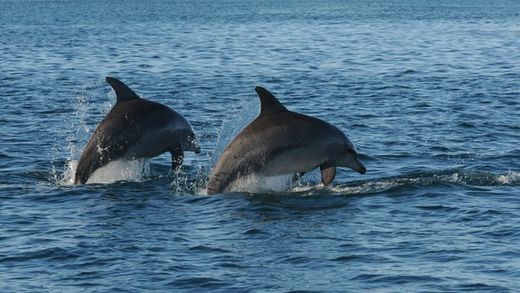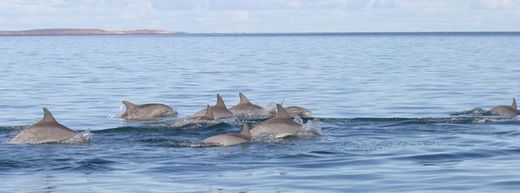
© BBCBonded male dolphins mimic each other's behaviour
Male bottlenose dolphins organise gang-like alliances - guarding females against other groups and occasionally "changing sides".
A team studying dolphins in Shark Bay, western Australia, say the animals roam hundreds of square kilometres, often encountering other dolphin groups.
The researchers observed the dolphins there over a five-year period, recording their movements.
They
report their findings in the Royal Society journal Proceedings B. Dr Richard Connor, a researcher from the US who took part in this study, first began his studies of the Shark Bay dolphins in the early 1980s.
This latest study reveals that these highly intelligent marine mammals live in an "open society". Rather than males guarding a specific territory, groups have what Dr Connor described as a "mosaic of overlapping ranges".
The fact that the dolphins travel in their troops and frequently encounter strangers reveals a great deal about their intelligence, because when one group meets another, the animals have to decide how to respond.
Shark Bay dolphins deal with this by organising themselves into three different types of alliances.
The first is pairs or trios that work together to capture and herd fertile females. "These consortships can last over a month," Dr Connor explained.
In a "second-order alliance", the animals form "teams" of between four and 14 males which mount attacks on other groups to take their females, or to defend against attacks.
In a third level, the dolphins have "friendly relations" between these larger teams; they join forces to form larger dolphin armies, working together to defend their females against other large, aggressive groups.

© BBCOnly humans and Shark Bay dolphins have multiple levels of social groups
Dr Connor explained to BBC Nature that animals need to be "incredibly smart" to operate in this type of society, where they often encountered other unfamiliar animals and had to work out whether they were a threat or an ally.
"The leading idea for the evolution of really large brains is that it was driven by complex social relationships," he told BBC Nature.
So rather than an encounter with another group of dolphins automatically resulting in "us against them" aggression, Shark Bay dolphins decide when to use friendly behaviour in order to make allies, and can even "switch sides".
Only humans and the Shark Bay bottlenose are known to have these multiple levels of male alliances in their social network.
Dr Nichola Quick, a researcher at the University of St Andrews' Sea Mammal Research Unit, told BBC Nature that understanding how animals managed social interactions in the wild was crucial in order to "truly understand their behaviour".
"If, for example, we are interested in impacts of [human] activity on animals," she said, "we can only really tell if an impact has occurred if we know what the animals 'normally' do."
I supposed it is used anthropomirphically to empahsize our humanness as gang are the opposite of elite control. Even though the article goes on to describe how this indicates intelligence.